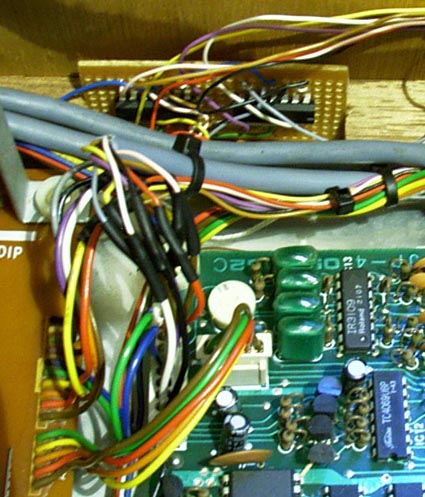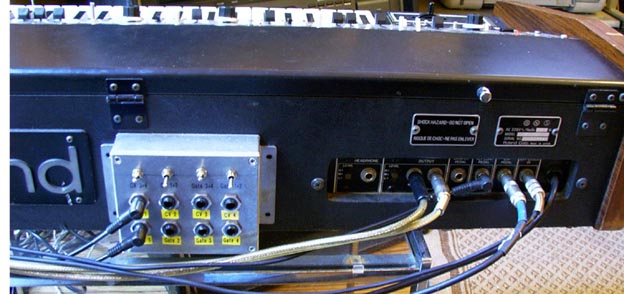Modifikation Roland Jupiter 4
This synthesizer from 1978 is considered to be one of the first polyphonic analog synthesizers, boasting a very peculiar and extremely 'phat' sound. The only big drawback about this machine is the missing possibility to actuate the 4 voices via CV/Gate signals (back then, MIDI hadn't been invented yet).

While intently studying the circuit diagramm, I learned that the oscillator actuation functions according to the Roland-typical 'volt-per-octave' principle, which can be processed by any cheap CV/Gate interface. I then found an easy possibility for external and polyphonic actuation via CV/Gate signals: a simple plug connection between motherboard (board with sound generators and filters) and key assigner board, containing all important signals (4 x Gate, 4 x CV), just needs to be seperated. The controller-produced signals can now be replaced by external CV/Gate signals.


Keeping the original setup intact was an essential issue for my rebuild. I constructed a small box with 8 switchable jack sockets (4 x CV and 4 x Gate) and four DPDTs and mounted them on the reverse side of the keyboard. I used the already present bores for the 'pitch circuit board' which, in turn, was relaid inside the housing. Each of the 4 DPDTs were now attached to the corresponding CV and Gate signal on the controller circuit board in one position, and to the respective jack socket tip in the other position. The middle contact leads to the according connection on the motherboard.
So, at the press of a switch, I can now control every single voice either by using the integrated keyboard or externally via CV/Gate signals. After trying around for quite a while, however, I decided to combine 2 voices each and assigned them to the switches as follows:
A: CV 1 + CV 2, B: Gate 1 + Gate 2, C: CV 3+ CV 4, D: Gate 3 + Gate 4

This layout enables the user to control the Gate signals externally and the CV signals via keyboard or vice versa. Jupiter's arpeggiator is thus fully utilizable and, at the same time, can be combined with the external signal controls. The arpeggiator's already-present external sync IN takes care of the right timing.
On top, the switchable jack sockets tips are fully connected (CV and gate each seperated), so when actuating with only one CV/Gate signal, all voices can be controlled, nevertheless. Jupiter 4's standard VCF, volume and sustain INs are also fully utilizable.
To be able to access all of Jupiter's features, you now need a CV interface with 7 CVs (4 voices + VCF + volume + sustain), 4 Gates and 1 synch OUT.

Jupiter 4's sound potential might not be as extensive as its brothers', Jupiter 6/8, but in my ears, it has a very strong profile and its style is a lot more unique than the rest of the "Jupiter/Juno bunch" put together. Jupiter 4 can rather be compared to the SH series, which lies close at hand considering the production date of 1978.
I choose 3 sound examples to portrait the Jupiter 4 as intensely as possible. The distortion on some sounds were created directly by the VCA amp (VCA level) and not added later.
